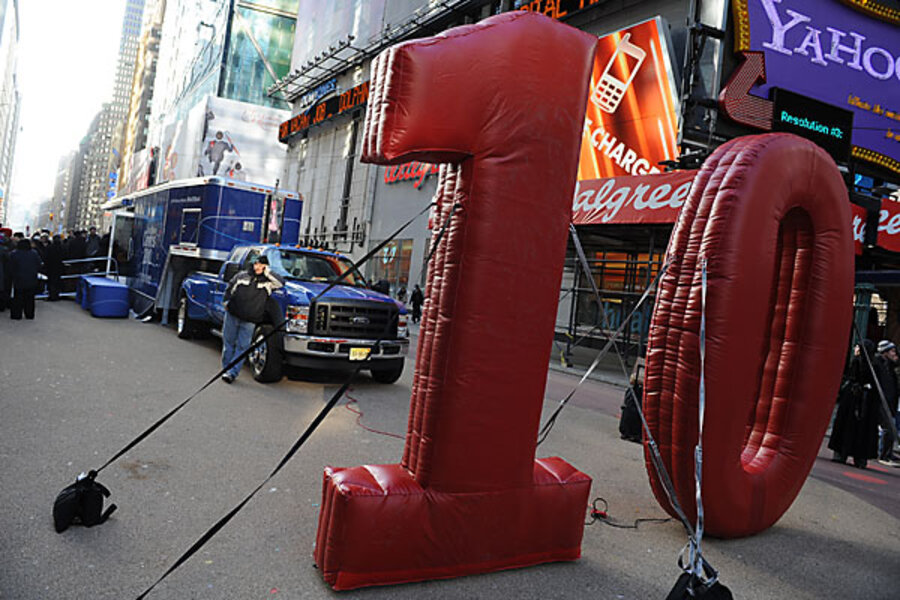2010 Census: what you need to know
Loading...
At the end of this month, a symbolic parade of dog sleds will head across the frozen tundra into Noorvik – an Alaskan fishing village of 634 people, according to the last US census.
On the dog sleds – as well as on some snowmobiles – will be officials carrying census forms. After the forms are filled out, they’ll tell the federal government if the Inupiat population of Noorvik has grown or shrunk.
Welcome to the official start of distributing forms for the 2010 Census, a national head count that is required by the US Constitution every 10 years.
Most of the 134 million residences in America will receive their questionnaire the conventional way – via first-class mail, starting March 15. However, not everyone has a postal address – and not everyone will reply to the blue-and-green form. So this year, the Census Bureau is hiring 800,000 people to follow up with door-to-door canvassing, set to begin May 1.
The scope of the census endeavor is Alaska-sized. In fact, it is the largest civic effort that the United States undertakes every decade. Congress has set aside $14 billion for the 2010 operation.
This time, the census form is 10 questions long – a length that officials maintain will take the average person 10 minutes to complete. If the 2000 census effort is any guide, about three-quarters of Americans will participate, despite a $130 million advertising and public-relations campaign.
Here are some common questions about the census:
How will census results be used?
The primary purpose of the census is to determine the apportioning of seats in the US House of Representatives. As a result of the 2000 Census, 18 states gained or lost seats. The biggest winners were Arizona, Florida, Georgia, and Texas, which each picked up two seats. New York and Pennsylvania lost two each. Polidata, a political data consulting firm, has predicted that the 2010 Census will result in a shift of 13 seats, with Texas potentially gaining four.
The US government will also use the census to determine how to divvy up $400 billion in annual federal spending for programs such as Medicaid.
How accurate is it?
The process has “a variety of -quality-control procedures built in,” says Robert Groves, census director. After the census itself is over, for example, the bureau will conduct another survey – “a large sample-based” one to see how well it did, Mr. Groves says.
The undercounting of residents is of particular concern to many states and cities. After the 2000 Census, the accounting firm PricewaterhouseCoopers, in a report to Congress, estimated that because of undercounting, 31 states and the District of Columbia lost $4.1 billion for eight federal programs between fiscal years 2002 and 2012.
Will the census count noncitizens?
Yes, US law requires a count of all “persons” and “inhabitants” – without specifying whether they are citizens or noncitizens, legal or illegal.
The First Congress was aware that many foreign-born people were living in the country, says Audrey Singer, a senior fellow at the Brookings Institution in Washington. “They intentionally did not use the term ‘citizen,’ ” she says of the 1790 law establishing the census.
Last October, four US senators attempted to put a question about citizenship on the 2010 census form. They were unsuccessful.
Am I required to fill out the form?
Yes, every resident is required by law to fill out the form – a fact that is noted on the mailing envelope. Yet some people have publicly stated that they don’t intend to do so. Only in rare cases, however, has the government prosecuted people for not complying with the law.
Who gets to look at the information I give?
By law, the Census Bureau cannot give the data to any government agency. For example, in the 1950s, the White House was being redecorated and President Truman and his wife needed to be relocated. The Secret Service wanted to know more about the people living near the first couple’s temporary residence, but the Census Bureau would not supply the requested information. In other instances, the US Supreme Court has upheld the secrecy of the data.
All census takers are checked by the Federal Bureau of Investigation. And they take an oath to never reveal personally identifiable information. The penalty for violating the oath is five years in prison and a fine of up to $250,000.
After the forms are processed, they go into a locked vault for 72 years. In 2012, the results of the 1940 survey will be open to the public.
Will a census taker come to my home?
Only if you have not mailed back the form.
Why can’t I answer the census questions online?
The Census Bureau considered this option but decided it didn’t save any money. Also, the bureau could not vouch for the security of the responses. Still, the bureau is trying to develop a secure online form for 2020.
---
Follow us on Twitter





